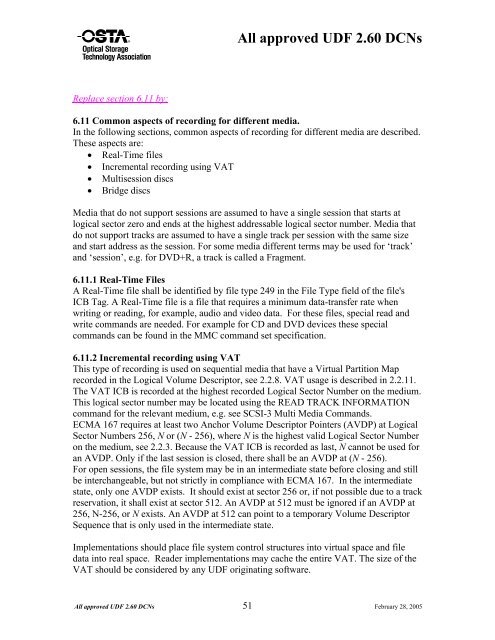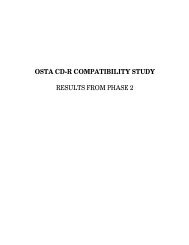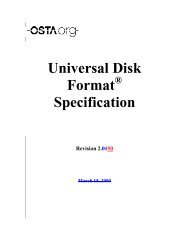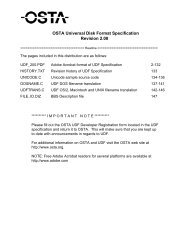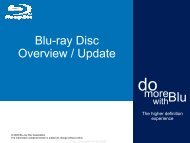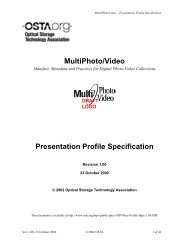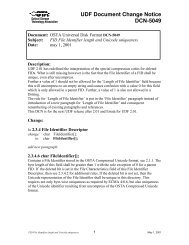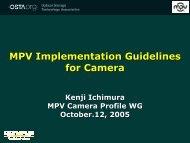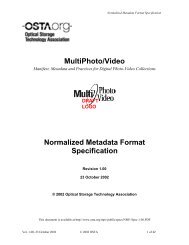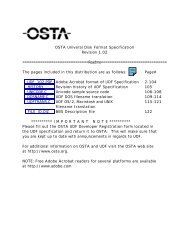All approved UDF 2.60 DCNs
All approved UDF 2.60 DCNs
All approved UDF 2.60 DCNs
You also want an ePaper? Increase the reach of your titles
YUMPU automatically turns print PDFs into web optimized ePapers that Google loves.
<strong>All</strong> <strong>approved</strong> <strong>UDF</strong> <strong>2.60</strong> <strong>DCNs</strong><br />
Replace section 6.11 by:<br />
6.11 Common aspects of recording for different media.<br />
In the following sections, common aspects of recording for different media are described.<br />
These aspects are:<br />
• Real-Time files<br />
• Incremental recording using VAT<br />
• Multisession discs<br />
• Bridge discs<br />
Media that do not support sessions are assumed to have a single session that starts at<br />
logical sector zero and ends at the highest addressable logical sector number. Media that<br />
do not support tracks are assumed to have a single track per session with the same size<br />
and start address as the session. For some media different terms may be used for ‘track’<br />
and ‘session’, e.g. for DVD+R, a track is called a Fragment.<br />
6.11.1 Real-Time Files<br />
A Real-Time file shall be identified by file type 249 in the File Type field of the file's<br />
ICB Tag. A Real-Time file is a file that requires a minimum data-transfer rate when<br />
writing or reading, for example, audio and video data. For these files, special read and<br />
write commands are needed. For example for CD and DVD devices these special<br />
commands can be found in the MMC command set specification.<br />
6.11.2 Incremental recording using VAT<br />
This type of recording is used on sequential media that have a Virtual Partition Map<br />
recorded in the Logical Volume Descriptor, see 2.2.8. VAT usage is described in 2.2.11.<br />
The VAT ICB is recorded at the highest recorded Logical Sector Number on the medium.<br />
This logical sector number may be located using the READ TRACK INFORMATION<br />
command for the relevant medium, e.g. see SCSI-3 Multi Media Commands.<br />
ECMA 167 requires at least two Anchor Volume Descriptor Pointers (AVDP) at Logical<br />
Sector Numbers 256, N or (N - 256), where N is the highest valid Logical Sector Number<br />
on the medium, see 2.2.3. Because the VAT ICB is recorded as last, N cannot be used for<br />
an AVDP. Only if the last session is closed, there shall be an AVDP at (N - 256).<br />
For open sessions, the file system may be in an intermediate state before closing and still<br />
be interchangeable, but not strictly in compliance with ECMA 167. In the intermediate<br />
state, only one AVDP exists. It should exist at sector 256 or, if not possible due to a track<br />
reservation, it shall exist at sector 512. An AVDP at 512 must be ignored if an AVDP at<br />
256, N-256, or N exists. An AVDP at 512 can point to a temporary Volume Descriptor<br />
Sequence that is only used in the intermediate state.<br />
Implementations should place file system control structures into virtual space and file<br />
data into real space. Reader implementations may cache the entire VAT. The size of the<br />
VAT should be considered by any <strong>UDF</strong> originating software.<br />
<strong>All</strong> <strong>approved</strong> <strong>UDF</strong> <strong>2.60</strong> <strong>DCNs</strong> 51 February 28, 2005


